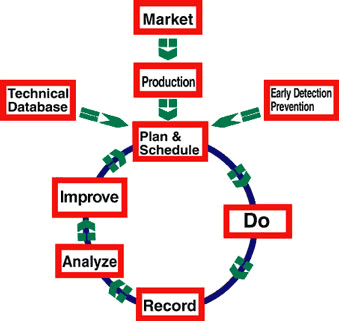The Conundrum
Conceptually, losing weight is a matter of eating less and exercising more. However, most attempts usually fail and we often gain weight. Similarly, healthy maintenance practices are very basic.
Yet again, most organizations fail to apply them successfully.
Success or failure with a weight loss plan has many elements in common with the application of sound maintenance principles and may help us avoid some common traps and failures.
This maintenance management article will hopefully provide some guidance.
Maintenance Management and Weight Loss
Most of us want to lose weight several times in a lifetime. The usual pattern is either to reduce caloric intake (eat less) or increase our overall metabolic level (exercise more) or a combination of both.
We further wow to stick to our plan (discipline). Together these principles represent the weight loss concept; eat less, exercise more, and be disciplined about it!
Just as simple as the concept for weight loss is the concept of good maintenance. We must prevent maintenance from occurring (exercise).
We must identify problems early (eat less) and we must plan our work and work our plan (be disciplined). Yet, so many plants struggle with adhering to sound, simple maintenance practices.
Why We Fail
The statistics are cruel; 95% of weight loss effort based on dieting alone, fail within 3-5 years. While I can’t produce statistics for maintenance management, common sense tells me that they would be fairly similar.
Among the most common causes cited for failure are:
- Reliance on only one measure.
- Making temporary changes but failing to address the long term behavior that produced the present condition.
- Overcomplicating the plan to change.
- Failure to recognize or correct a resource balance or attitude of which the current state is the outcome.
- Over reliance on technology or a silver bullet.
- Trying to do it on your own.
Even after scrutinizing this list closely, it would be hard to find an item that did not apply to both maintenance improvement and weight loss success. While there are hundreds of ways to go about improvement, there are several important junctions and turns you should not miss on the road to sound maintenance and weight loss practices. Let’s look at them in turn.
Recognize the Need
First and foremost we must recognize collectively as an organization that we are over weight. It time to acknowledge that our trouser are not shrinking slightly in every wash.
Denial is the first obstacle to overcome.
Too many times have I wondered over the PM actions prompting crafts people to do on-the-run-inspections of belts and couplings better guarded and inaccessible than Fort Knox.
Yet the same plant’s management and craftspeople indignantly defend their preventive maintenance program as “very good” or “better than most others’”.
Such attitudes and misconceptions often run very deep and many of these plants are hard to persuade to change their ways, even after you tell them that preventive maintenance has an ROI of 100 – 1000%, or that an effective planner can be as productive as five craftspeople.
In such situations, I feel like I’m standing on a busy street corner in New York City trying vigorously to give away perfectly good $100 bills, without success.
Create Vision, Mission, and Goals
This weight problem may be absolutely clear in your mind, but make sure that you have significant support within management and frontline layers of the organization before your continue.
It is too hard to slug it alone.
Try to be the sparkplug instead of the piston! Many organizations have success with taking key people in management AND the front line on discovery visits to other organizations.
After the organization has acknowledged the need and completed a self examination, you are part of the way toward the second step, quantify your gap and establish a vision, a future state that you will always want to reach for.
Most of us could not imagine a weight loss program without a scale to know when have reached our goal. Yet, many plants and plant managers embark on maintenance improvement without having defined good maintenance.
This goes to the core of the matter. If we do not know how to define good maintenance, how will we know when we reach it?
Another big challenge with the mission, vision and the goals is making them all as public as possible; to include and involve many stakeholders. It is so much easier to quietly renege on your plan to yourself, than in front of your friends, family, or colleagues.
Communicate with and involve and people around you.
Then, if your co-workers see you popping those chocolate bars and sodas all day, they are much more likely to put a lock on the fridge and help you succeed. Broad involvement will likely also provide a reality check for your planning.
Identify Key Success Proxies
At this juncture, you have a mission, a crew that is inspired, aware and wants to go places. The next thing to do is to identify success proxies. Proxy means the power or authority to act for another, which is exactly what success proxies will do.
They are the processes, procedures or actions that drive the result the organization strives for. For people following the famous Atkins diet, no sugar and staying away from carbohydrate rich foods like pasta, rice, and bread are success proxies.
Maintenance success proxies are qualified best practices such as precision alignment and dynamic balancing for all rotating elements, filtering lubricants, conducting root cause problem elimination, and plan all work before it’s scheduled.
When you identify success proxies for craftspeople, you soon see that some relate to documentation and management other to execution and follow up, thus engaging all layers of the organization in meaningful activities that all directly act for another; the global success measures for the organization.
These measures typically describe output, quality and cost. Think of proxy drivers as value added activities on steroids.
An excellent way of identifying these success proxies is to have a detailed best practices audit done in your organization. There are many organizations providing such services to industry.
The outcome of such an assessment will be a comprehensive mapping of best practices organized by process, craft skills, organizational area or similar.
Sometimes, but not always, it will also identify associated metrics for each practice. Basing your improvement plan on a detailed best practice map, yields other benefits too.
First, your plan will be relevant and close to the people who must make the changes, craftspeople, operators and supervisors.
Second, you are specifying what needs to be done, yet leaving room for the frontline to use their trade skills to decide how best accomplish it.
Third, by comparing best practices with actual practices, you automatically identify and correct the long term reason you are where you are.
Finally, you are also making your improvements on a broad base, thus ensuring better resilience against failure, allowing all people to contribute their strengths while recognizing the good practices already in place.
Some people ague that you can map your processes internally instead of hiring and external consultant.
They are right, you can!
A couple of words of caution though!
t takes a lot of persistence and time to identify, define and benchmark best practices. If you benchmark your maintenance function alone or as a small group, arm yourself with lots of time, initiative and pray that your superiors have the vision and patience to see you through.
Ask yourself, if you were trying to lose weight, would you start by re-writing the nutritional or exercise guide?
Of course I’m biased toward using an outside professional. What you need is a comprehensive audit providing a richly detailed, honest comparison of where you are and where you could be.
Time and time again, we have seen internal audits scoring themselves twice as high as the independent outsider would.
Fig 1 demonstrates a partial such document for part of the process of planning and scheduling. The right hand side shows where you are, the left where you could be. Please contact me if you need a more detailed sample and description of this document
| Best Practices | Actual Plant Practices |
| III. Backlog Backlog Documentation
12. Documented definitions and backlog work process flow are available and well disseminated. | III. Backlog Score 50 Backlog Documentation
12 Backlog management processes are not documented well. Nor are they widely available or understood by maintenance craftspeople or managers. |
|
Backlog Execution 13. Work order backlog is reviewed jointly by operations and maintenance throughout the plant. 14. Backlog is categorized by area, skills, hold codes, daily/weekly and shutdown/ outage. 15. Backlog is reviewed weekly by Operations and Maintenance: 16. Work orders statuses (in backlogs) are updated automatically when parts arrive for “awaiting parts” status work orders. |
Backlog Execution 13 The plant does review the backlog jointly in all areas. 14 The CMMS system have many sorting capabilities, but few areas use the management tools available in CMMS to sort the backlog. 15 The backlog is reviewed weekly by operations and maintenance. The backlog is not always sorted by age and the correct priority but the plant does a good job of reviewing work orders. Many work orders in the backlog are unplanned, which prevents thorough review. 16 Though the CMMS does have this capability, it is not used. |
Figure 1. Extract from best practices document showing, planning and scheduling, backlog documentation and execution. The left hand shows best practice, the right, actual plant practice.
Measure Success Proxies Metrics
By definition, if you focus on doing the right things, weight loss and the good maintenance results will follow, else, they were not the right things.
It then follows logically, that you use metrics based on the success proxies to track performance. The percent completion of established pm rounds, percent of rotating equipment aligned and balanced to specs feel more relevant and close to a journeyman, than does the Overall Equipment Efficiency (OEE).
Likewise, the net amount of carbs and calories you have consumed and burnt, feel like a more relevant day to day measure to the dieter, than does the ultimate and distant goal of X pounds of weight loss.
For the Atkins dieter, the performance measure is to have a maximum of 20 quality carbs per day. In the plant, your challenge is to build a hierarchy of relevant indicators reflecting the work that drives your organization toward success.
The discipline of sales management has long used the concepts of success proxies and their associated metrics to create sales forecasts and measure progress.
The breakdown can look as follows: Say on average it takes 10 cold calls to make a sale worth $8,000 on average 8 weeks after the call. Therefore, to sell $100,000 in a month, we need to make 130 canvass calls 8 week before we can close 13 sales of $8,000 each.
Below is a simple example of a model focusing the organization on the right processes instead of the end result. It contains all the essential elements of maintenance and illustrates how they interact.
The focus must be on the success proxies, things you can affect hour by hour of your day. When you do these things right, the record productions will be there, over and over again.

Figure 2, Productivity improvement circle showing the essential elements of maintenance and their interaction with each other. This process represents a success proxy.
Conclusion
After putting the appropriate success proxies and select associated metrics in your plan, do schedule several reviews to be able to fine tune your plan and re-distribute resources as needed.
Also, make sure that you plan for the long term. Our weight gain and the current status of our plant developed over a long time, so the solution must also be one for the long term.
If you think of this as a “project”, you set yourself up for failure, for by definition, a project has a defined end. What you need above everything is long term sustainable change, a process, a new way of living.
I hope the advice and information shared in this article will to some small measure help you, whether you are seeking to improve you maintenance, or reduce your weight.
Please feel free to contact me regarding this article, I do enjoy the feedback whether you agree or disagree.





